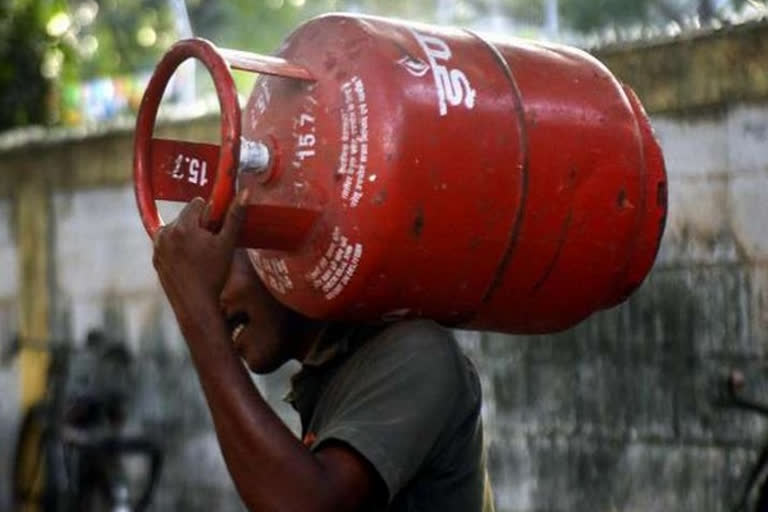New Delhi: The price of 19 kg commercial cooking gas LPG has been hiked by Rs 250 per cylinder. It will now cost Rs 2253 effective from today. On the other hand, there has been no increase in the prices of domestic gas cylinders. The government on Thursday had more than doubled the price of domestically produced natural gas for the six months beginning April 1 on the back of a spike in global energy rates. The price of gas from regulated fields of state-owned ONGC and Oil India Ltd will rise to a record USD 6.10 per million British thermal units from the current USD 2.90, according to a notification issued by the oil ministry's Petroleum Planning and Analysis Cell (PPAC). The rate paid for difficult fields like deepwater will rise to USD 9.92 for April-September from USD 6.13 per mmBtu, it said.
The new price, which is likely to result in a hike in CNG and piped cooking gas rates, will be for six months beginning April 1. Petrol and diesel prices have been raised nine times in the last 10 days, totalling Rs 6.4 per litre while cooking gas LPG rates too have gone up by Rs 50 per cylinder. The latest gas price hike will further fuel inflation. The rate applicable to newer and difficult fields such as ones of Reliance Industries Ltd in the deepsea KG-D6 block will get USD 9.92 per mmBtu for April-September as compared to the current USD 6.13 per mmBtu, the PPAC notification said. These are the highest prices ever paid to Indian gas producers.
The government sets the price of gas every six months -- on April 1 and October 1 -- each year based on rates prevalent in gas surplus nations such as the US, Canada and Russia. The increase in gas price is likely to result in a 10-15 per cent rise in CNG and piped cooking gas rates in cities such as Delhi and Mumbai, industry sources said. Prashant Vasisht, Vice President and Co-Head, Corporate Ratings, ICRA Ltd, said: "The domestic gas price increase was driven by the significant run-up in the prices of gas at global gas hubs. The increase in gas prices provides relief to Indian upstream producers as at earlier prices, gas production was a loss-making proposition for most fields for the Indian upstream producers."
CNG and piped cooking gas supplies in cities come from the gas produced by ONGC. The price hike will also lead to a rise in the cost of generating electricity but consumers may not feel any major pinch as the share of power produced from gas is very low. Similarly, the cost of producing fertiliser will also go up but as the government subsidises the crop nutrient, an increase in rates is unlikely. This is the second straight hike in prices and betters USD 5.05 paid to ONGC and Oil India Ltd for old fields between November 2014 and March 2015 and USD 9.32 to newer fields in April-September 2019.
Also read: Air travel to become costlier, jet fuel prices hiked by 2% to all-time high
The new rates reflect the spike in prices at the global benchmarks - US-based Henry Hub, Canada-based Alberta gas, UK-based NBP and Russia gas as well as in rates of liquefied natural gas (LNG) in 2021 following a supply crunch with the return of demand after devastation by the pandemic. Domestic rates are fixed based on the volume-weighted average price in a year in these global benchmarks with a lag of one quarter. So, the price for April 1 to September 30 is based on the average price from January 2021 to December 2021. This is the period when global rates shot through the roofs. For difficult fields like discoveries in deepwater, ultra-deepwater and high pressure-high temperature areas, a slightly modified formula is used by incorporating the price of LNG, which too had shot through the roof in 2021.
Reliance-bp operated KG fields are classified as difficult fields. Such field operators are allowed to discover market price but this is subject to a cap fixed for the difficult fields twice every year. For producers, this will be the first time in six years that they will get a remunerative price. ONGC had been incurring losses on the 65 million standard cubic meters per day of gas it produces from domestic fields shortly after the government in November 2014 introduced a new gas pricing formula that had "inherent limitations" as it was based on pricing hubs of gas surplus nations. The sources said ONGC had in several communications to the government stated that the break-even price to produce gas from new discoveries was in the range of USD 5-9 per mmBtu and that for old fields such as Mumbai High and Bassein is about USD 3.6-3.7 per mmBtu.
The Congress-led UPA had approved a new pricing formula for implementation in 2014 that would have raised the rates, but the BJP-led government scrapped it and brought a new formula. The new formula takes into account the volume-weighted annual average of the prices prevailing in Henry Hub (US), National Balancing Point (the UK), Alberta (Canada), and Russia with a lag of one-quarter. The rate at the first revision, using the new formula, came to USD 5.05 per mmBtu but in the subsequent six-monthly reviews kept falling till it touched USD 2.48 per mmBtu for April 2017 to September 2017 period. Subsequently, it rose to USD 3.69 per mmBtu in April 2019-September 2019 before being cut in subsequent rounds to USD 1.79 per mmBtu.
Also read: Opp protest in Lok Sabha over fuel price hike
PTI



